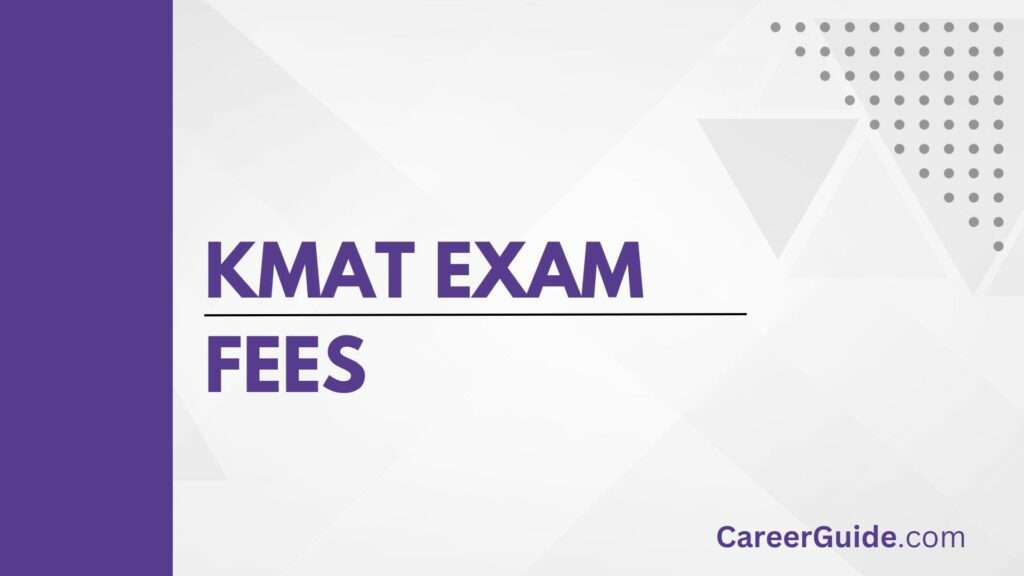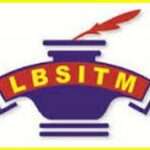KMAT Exam Fees: The Karnataka Management Aptitude Test (KMAT) is a state-level management entrance examination conducted by the Karnataka Private Post Graduate Colleges Association (KPPGCA). KMAT is a gateway for admission to MBA, PGDM, and MCA programs offered by various B-schools and universities in the state of Karnataka.
To succeed in KMAT, it’s crucial to have a comprehensive understanding of the exam syllabus. In this extensive guide, we will explore the KMAT syllabus in detail, covering various aspects of each section, key topics, and preparation strategies.

KMAT Exam Overview
Before diving into the specifics of KMAT exam fees, let’s briefly understand what the KMAT exam is all about.
Purpose: The KMAT exam is conducted to assess the aptitude and skills of candidates seeking admission to postgraduate management and computer application programs.
Conducting Authority: The Karnataka Private Post Graduate Colleges’ Association (KPPGCA) is responsible for organizing the KMAT exam.
Eligibility: The eligibility criteria for KMAT may vary slightly from year to year. Typically, candidates should have a Bachelor’s degree with a minimum percentage (usually 50% for general category and 45% for reserved category candidates) from a recognized university.
Exam Pattern: KMAT is a pen-and-paper-based test comprising multiple-choice questions (MCQs). The test assesses a candidate’s proficiency in subjects like Language Comprehension, Mathematical Skills, Basic Aptitude, and Logical Reasoning.
Participating Institutions: Several B-schools and universities in Karnataka accept KMAT scores for admission, making it a crucial exam for MBA and MCA aspirants in the state.
KMAT Exam Fees
Now, let’s delve into the specifics of KMAT exam fees:
Fee Structure: The KMAT exam fee structure may vary from year to year, and it can also differ for various categories of candidates. Typically, there are separate fee structures for different courses like MBA and MCA.
General Category Candidates: As of my last knowledge update in September 2021, the KMAT exam fee for general category candidates ranged from approximately INR 800 to INR 1000. This fee includes the cost of the application form and the exam.
Reserved Category Candidates: Candidates belonging to reserved categories, such as SC/ST, might be eligible for a reduced fee. This fee could be around INR 500 to INR 700. However, it’s essential to check the latest fee structure when applying for the exam, as it may have changed since my last update.
Mode of Payment: KMAT exam fees can usually be paid online through various modes, including credit/debit cards, net banking, and other digital payment methods. Detailed payment instructions are provided during the registration process.
Late Fee: It’s crucial to note that KMAT has specific deadlines for registration. If a candidate misses the regular registration window, they may still be able to apply during the late registration period. However, late registration often incurs an additional fee.
Refund Policy: KMAT’s refund policy may vary, so candidates should carefully read the terms and conditions regarding fee refunds on the official website.
Fee Waivers: In some cases, candidates facing financial hardship might be eligible for fee waivers or concessions. Such provisions, if available, are usually mentioned in the official notification.
KMAT Registration Process
Now that we have discussed the fee structure let’s walk through the general steps involved in the KMAT registration process:
Online Registration: Candidates need to visit the official KMAT website to register for the exam. They must provide essential details such as name, contact information, educational qualifications, and more.
Fee Payment: After filling in the registration form, candidates are required to make the payment of the applicable exam fee through the provided online payment options.
Uploading Documents: Candidates may be asked to upload scanned copies of their photograph and signature as per the specified format and size guidelines.
Confirmation: After successful fee payment and document upload, candidates will receive a confirmation of their registration. They should carefully review all the information provided for accuracy.
Admit Card: Admit cards for the KMAT exam are typically released a few weeks before the exam date. Candidates can download their admit cards from the official website by logging in with their credentials.
Exam Date and Venue: The admit card will contain details about the date, time, and venue of the KMAT exam. Candidates must follow the instructions provided on the admit card.
Exam Day: On the day of the exam, candidates should arrive at the exam center well before the reporting time. They must carry a printout of their admit card, a valid photo ID, and any other documents as specified in the instructions.
Result Declaration: After the exam, KMAT releases the results on its official website. Candidates can check their scores and download the scorecard using their login credentials.
KMAT Syllabus
Now, let’s dive into the detailed syllabus for each section of the KMAT exam:
1. Verbal Ability and Reading Comprehension:
This section evaluates your language skills, including your ability to understand and analyze written material effectively. Key topics in this section include:
Reading Comprehension: You’ll encounter passages on various topics and be asked questions that test your understanding of the passage, including its main idea, supporting details, and inferences.
Vocabulary: Questions related to synonyms, antonyms, analogies, and word meanings are common.
Grammar: This includes questions on sentence correction, spotting errors, sentence completion, and other grammar-related topics.
Jumbled Sentences: You may be required to arrange a set of jumbled sentences to form a coherent paragraph or sequence.
Sentence Rearrangement: Similar to jumbled sentences, this involves rearranging sentences to create a meaningful passage.
Para Jumbles: These questions require you to arrange a set of sentences to form a coherent paragraph.
Quantitative Ability
The Quantitative Ability section assesses your mathematical skills and ability to solve numerical problems. Key topics in this section include:
Arithmetic: This includes topics like percentages, ratios and proportions, profit and loss, time and work, time and distance, averages, and simple and compound interest.
Algebra: Algebraic topics such as equations, inequalities, functions, and quadratic equations are tested.
Geometry: Geometry questions may involve concepts related to lines, angles, triangles, circles, polygons, and mensuration.
Trigonometry: Basic trigonometric concepts and identities may be included in the syllabus.
Data Interpretation: Questions in this category require you to analyze and interpret data presented in various forms, including tables, graphs, charts, and diagrams.
Number System: Questions related to properties of numbers, divisibility rules, and remainders may be included.
Probability and Statistics: Basic concepts of probability and statistics, such as mean, median, mode, and standard deviation, may be tested.
Logical Reasoning
The Logical Reasoning section evaluates your ability to think logically, analyze information, and make deductions. It assesses your problem-solving skills and your ability to draw conclusions based on given information. Key topics in this section include:
Puzzles: Various types of puzzles, such as seating arrangement puzzles, arrangement-based puzzles, and grid-based puzzles, are commonly featured in this section. These require logical thinking and the ability to make connections.
Blood Relations: Questions related to familial relationships, often involving complex family trees, are asked to assess your ability to deduce relationships.
Coding-Decoding: These questions involve coding and decoding words or phrases using specific patterns or rules.
Series: This includes number series, letter series, and mixed series questions that require identifying patterns and predicting the next item in the series.
Syllogism: Syllogism questions test your ability to draw logical conclusions from given statements using Venn diagrams or other logical methods.
Direction Sense: Questions related to directions, distances, and movement of objects or individuals.
Assumptions and Conclusions: You’ll be asked to identify assumptions underlying an argument and draw logical conclusions based on given information.
Data Sufficiency: These questions assess your ability to determine whether the given data is sufficient to answer a specific question.
Preparation Tips for KMAT
Now that you’re familiar with the KMAT syllabus, here are some tips to help you prepare effectively:
Understand the Syllabus: Start by thoroughly understanding the syllabus and the topics covered in each section.
Create a Study Plan: Develop a study plan that covers all sections of the syllabus. Allocate more time to areas where you need improvement.
Practice Regularly: Regular practice is the key to success. Solve a variety of questions from different topics to enhance your problem-solving abilities.
Mock Tests: Take full-length mock tests regularly to simulate the actual exam environment. Analyze your performance in these tests to identify areas that need improvement.
Focus on Weak Areas: Identify your weak areas and work on improving them. Whether it’s mathematics, reasoning, or language skills, targeted practice can make a significant difference.
Speed and Accuracy: KMAT demands both speed and accuracy. Strive to strike a balance between solving questions quickly and ensuring they are correct.
Reading Habit: Develop a habit of reading newspapers, magazines, and business articles to improve your reading comprehension skills.
Stay Updated: Keep up with current affairs and general knowledge as they are often tested in reading comprehension passages.
Stay Calm: On the day of the exam, stay calm and composed. Avoid last-minute cramming and focus on what you’ve learned during your preparation.
No Negative Marking Advantage: Remember that as of my last knowledge update in September 2021, KMAT did not have negative marking. So, attempt all questions, even if you are unsure about some.
Important Considerations for KMAT Exam Fees
When dealing with KMAT exam fees, candidates should be aware of several crucial considerations:
1. Fee Concessions for Reserved Categories:
- Candidates belonging to reserved categories such as Scheduled Castes (SC), Scheduled Tribes (ST), Other Backward Classes (OBC), Economically Weaker Sections (EWS), and others may be eligible for fee concessions or waivers.
- The extent of the fee concession and the eligibility criteria may vary from year to year.
- To avail of fee concessions, candidates must provide the necessary documents and meet the specified criteria.
2. Fee Refund Policy:
- KMAT registration and application fees are typically non-refundable.
- In the event of a fee dispute or unusual circumstances, candidates should refer to the official KMAT website or contact the organizing authority for clarification on the refund policy.
3. Verification of Payment:
- After making a payment, candidates should keep a record of the transaction, such as payment receipts, challan copies, or DD details.
- This documentation serves as proof of payment and may be required during the application process or for any future reference.
4. Payment Deadlines:
- KMAT has specific deadlines for both regular and late fee payments.
- Candidates should pay attention to these deadlines and ensure that their payments are made within the stipulated time frames to avoid missing out on the opportunity to take the exam.
5. Be Cautious of Unauthorized Sources:
- To prevent fraud and unauthorized fees, candidates should make payments only through the official KMAT website or authorized channels.
- Avoid making payments through unofficial websites, agents, or intermediaries.
6. Check Fee Details Carefully:
- When filling out the application form, candidates should double-check the fee details to ensure they are paying the correct amounts based on their category and the applicable fees.
7. Fee Structure Changes:
- Candidates should be aware that the fee structure for the KMAT exam can change from one year to another.
- It is essential to refer to the official KMAT website for the most current fee details for the year in which you plan to take the exam.
Payment Methods for KMAT Exam Fees
To make the payment process convenient for candidates, KMAT typically offers multiple payment methods. Here are some common payment methods that candidates can use to pay their KMAT exam fees:
1. Online Payment:
- Online payment is one of the most popular and convenient methods for paying KMAT exam fees.
- Candidates can make online payments using debit cards, credit cards, or net banking.
- During the application process, candidates will be directed to a secure payment gateway where they can enter their payment details and complete the transaction.
2. Bank Challan:
- Some candidates may prefer to make cash payments through bank challans.
- To use this method, candidates need to generate a bank challan during the application process.
- After generating the challan, candidates can take it to the designated bank branch and make a cash payment.
- The bank will provide a payment receipt, which the candidate should retain as proof of payment.
3. Demand Draft (DD):
- Another payment option is to make a payment via Demand Draft (DD).
- Candidates need to prepare a DD for the specified fee amount in favor of the designated authority.
- The DD should be payable at a bank branch in the city where the candidate intends to submit their application.
- The candidate should include the DD details in the application form and submit it along with other required documents.
4. Online Wallets and Mobile Payment Apps (if available):
- In some cases, KMAT may partner with online wallet providers or mobile payment apps to facilitate payments.
- Candidates can choose this method if it is offered during the application process.
5. NEFT/RTGS (Electronic Funds Transfer):
- Candidates may have the option to make payments via NEFT or RTGS, especially for larger transactions.
- This method allows candidates to transfer funds directly from their bank accounts to the designated account of the organizing authority.
KMAT Admission Process
The KMAT affirmation prepare shifts from B-school to B-school. Be that as it may, most B-schools will consider your KMAT score, your scholarly record, and your work encounter (in case any) when making confirmation choices.
Here could be a common diagram of the KMAT affirmation process:
Apply to the B-schools you’re inquisitive about. Most B-schools acknowledge online applications.
Yield your KMAT scorecard and other required archives. The desired records may change from B-school to B-school, but they may incorporate your transcripts, letters of suggestion, and a statement of reason.
Shortlisted candidates will be called for an meet. The meet is an opportunity for the B-school to memorize more around you and your inspiration for seeking after an MBA or PGDM degree.
After the meet, the B-school will release a last justify list. The justify list will be based on your KMAT score, your scholarly record, your work involvement, and your execution within the meet.
Chosen candidates will be advertised affirmation to the B-school.
Here are some tips for the KMAT confirmation prepare:
Begin early. The KMAT confirmation handle can be time-consuming, so it is critical to begin early.
Investigate the B-schools you’re inquisitive about. Make beyond any doubt you get it the affirmation criteria, the expenses, and the job placement record of each B-school.
Plan for your interviews. Be arranged to reply questions almost your scholastic foundation, your work involvement, and your career objectives.
Take after up with the B-schools you’ve got connected to. After you’ve got submitted your application, take after up with the B-schools to check the status of your application and to reply any questions they may have.
I trust this data is supportive. If it’s not too much trouble let me know in case you have got any other questions.
FAQs
A: There are three sections in the KMAT exam:
- Quantitative Aptitude
- Verbal Ability
- Logical Reasoning
A: There are 60 questions in each section of the KMAT exam.
A: The total duration of the KMAT exam is 3 hours.
A: Each question in the KMAT exam carries 4 marks. There is no negative marking for incorrect answers.
A: There is no sectional cut-off in the KMAT exam. However, candidates must score a minimum of 30% in each section to be eligible for the final merit list.










